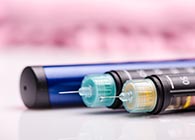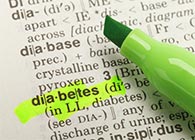October 2014
October 2014
Safety, effectiveness, and cost effectiveness of long acting versus intermediate acting insulin for patients with type 1 diabetes
Andrea C Tricco et al. BMJ. Doi: 10.1136/bmj.g5459
This systematic review of trials of long acting (glargine, detemir) and intermediate acting (neutral protamine Hagedorn (NPH), lente) insulin for adults with type 1 diabetes looked at the safety, effectiveness, and cost effectiveness of long acting insulin for type 1 diabetes. In all 39 studies (7,496 patients) were included in the exercise. The conclusions were that long acting insulin analogs were probably superior to intermediate acting insulin analogs, although the difference was small for HbA1c. The authors advise that patients and their physicians should tailor their choice of insulin according to preference, cost, and accessibility.
http://www.bmj.com/content/349/bmj.g5459
HbA1c levels and risk of severe hypoglycemia in children and young adults with type 1 diabetes from Germany and Austria
Beate Karges et al. PLOS Medicine. Doi: 10.1371/journal.pmed.1001742
In the past it has been shown that low levels of HbA1c, a marker of average plasma glucose, could predict a high risk of severe hypoglycemia, but it is uncertain whether this association still exists. Because of advances in diabetes technology and pharmacotherapy the authors hypothesized that the association between severe hypoglycemia and HbA1c has decreased in recent years. To investigate this they analysed data of 37,539 patients with type 1 diabetes looking at associations between severe hypoglycemia, hypoglycemic coma, and HbA1c levels. It was found that the previously strong association of low HbA1c with severe hypoglycemia and coma in young individuals with type 1 diabetes has substantially decreased in the last decade, allowing achievement of near-normal glycemic control in these patients.
http://www.plosmedicine.org/article/info:doi/10.1371/journal.pmed.1001742
National Diabetes Audit – 2012-2013: Report 1, Care Processes and Treatment Targets
Health and Social Care Information Centre.
This national report from the tenth year of the audit presents key findings on key care processes and treatment target achievement rates from 2012-2013 in all age groups in England and Wales. Achievement of all three NICE recommended treatment targets show marked difference among the different age groups. It is the continued finding that younger people with Type 1 or Type 2 diabetes and people with Type 1 diabetes at all ages less often receive all the annual care processes or achieve the basic treatment targets. As people get older or if they have Type 2 diabetes they are more likely to have achieved the treatment targets. (HSCIC)
http://www.hscic.gov.uk/searchcatalogue?productid=15512&q="National+diabetes+audit"&sort=Most+recent&size=10&page=1
Artificial sweeteners induce glucose intolerance by altering the gut microbiota
Jotham Suez et al. Nature. D oi: 10.1038/nature13793
Non-caloric artificial sweeteners (NAS) are among the most widely used food additives worldwide, regularly consumed by lean and obese individuals alike. NAS consumption is considered safe and beneficial owing to their low caloric content, yet supporting scientific data remain sparse and controversial. Here the investigators demonstrate that consumption of commonly used NAS formulations drives the development of glucose intolerance through induction of compositional and functional alterations to the intestinal microbiota. The experiments were conducted in mice but the authors assert that they have demonstrated similar NAS-induced glucose intolerance in healthy human subjects. As a result of their findings the authors are calling for a reassessment of massive NAS usage.
http://www.nature.com/nature/journal/vaop/ncurrent/full/nature13793.html
Safety and effectiveness of biphasic insulin aspart 30 in people with type 2 diabetes switching from basal-bolus insulin regimens in the A1chieve study
Guillermo Dieuzeide et al. Primary Care Diabetes. Doi: 10.1016/j.pcd.2013.07.005
Biphasic insulin aspart 30 allows fewer daily injections versus basal-bolus insulin regimens, which may improve adherence and treatment outcome. This paper is an analysis of a study that assessed the clinical safety and effectiveness of biphasic insulin aspart 30 in people with type 2 diabetes previously receiving basal-bolus insulin regimens.1,024 patients were included in the study. At 24 weeks, HbA1c and fasting plasma glucose were significantly reduced from baseline and the proportion reporting any hypoglycaemia, major hypoglycaemia or nocturnal hypoglycaemia was significantly reduced. No serious adverse drug reactions were reported. Health-related quality of life (HRQoL) was also improved. The authors conclude that at 24 weeks after switching from basal-bolus insulin regimens to biphasic insulin aspart 30, glycaemic control and HRQoL were significantly improved, and hypoglycaemia was significantly reduced. They assert that their analysis suggests that people with type 2 diabetes inadequately controlled on basal-bolus insulin regimens can consider biphasic insulin aspart 30.
http://www.primary-care-diabetes.com/article/S1751-9918(13)00085-5/abstract
The experiences of diabetics on self-monitoring of blood glucose: a qualitative metasynthesis
Chen-Mei Chen et al. Journal of Clinical Nursing. Doi: 10.1111/jocn.12691
The authors report that patients exhibit both positive and negative perceptions towards the self-monitoring of blood glucose, and that numerous recent qualitative studies have explored the self-monitoring of blood glucose experiences of diabetic patients – however, no integrated results have been provided. In this systematic literature analysis patients with diabetes were divided into five themes: perceived disease severity, effects on daily life, lifestyle adjustments after becoming aware of blood glucose levels, determining the meaning of self-monitoring, and the differences between diabetic patients who use and do not use insulin. It was found that individual differences in blood glucose self-monitoring varied widely among diabetic patients, and that these differences arose from personal cognition and feelings concerning blood glucose monitoring. [Cognition is the set of all mental abilities and processes related to knowledge]. The authors posit that insights into, and discussions regarding the self-monitoring of blood glucose experiences of diabetic patients would enable health care professionals to understand the factors that influence the intentions of patients to perform self-monitoring of blood glucose and would facilitate the establishment of customised self-monitoring of blood glucose treatment plans.
http://onlinelibrary.wiley.com/doi/10.1111/jocn.12691/abstract
Insulin pumps (CSII) and cardiovascular diseases and mortality in the Swedish national diabetes register
S. Gudbjörnsdottir et al. Presentation Abstract, EASD.
This abstract from the recent EASD meeting in Vienna stated that insulin pump treatment (CSII) improved glycemic control and quality of life. It also stated that studies on the effect of CSII on long-term risk for cardiovascular diseases (CVD) and mortality were lacking. The research compared 2,136 patients with type 1 diabetes using CSII with 13,028 patients using insulin injections. The data was taken from the Swedish National Diabetes Register. The findings were that there was risk reductions of around 5% for cardiovascular diseases and mortality with CSII when compared to insulin injections in patients with type 1 diabetes who were followed for 6 years.
http://www.abstractsonline.com/Plan/ViewAbstract.aspx?sKey=2262c29a-3e73-46e9-a6ea-6a7610bcad6d&cKey=312c2c3d-8db2-4252-bbc3-e9aacbfe8e4b&mKey=a1c98495-3d5b-461a-ab97-eeb119269c55#
Diabetes, antidiabetic medications, and pancreatic cancer risk: an analysis from the International Pancreatic Cancer Case-Control Consortium
C. Bosetti et al. Annals of Oncology. Doi: 10.1093/annonc/mdu276
The introduction to this paper reminds us that type 2 diabetes has been associated with an excess risk of pancreatic cancer, but the magnitude of the risk over time remains unclear, and that there is limited information on the role of antidiabetic medications. The investigators analysed individual-level data from 15 studies from the Pancreatic Cancer Case-Control Consortium, including 8,305 cases and 13, 987 controls. The results showed that 15% of cases and 8% controls reported a diagnosis of diabetes two or more years before cancer diagnosis. Pancreatic cancer risk decreased with duration of diabetes, but a significant excess risk was still evident 20 or more years after diabetes diagnosis. It was also discovered that long duration of oral antidiabetic use was associated with a decreased pancreatic cancer risk but conversely insulin use was associated with a pancreatic cancer risk in the short term but not for longer duration of use. The authors assert that the study provided the most definitive quantification to date of an excess risk of pancreatic cancer among diabetics. It also shows that a 30% excess risk persists for more than two decades after diabetes diagnosis, thus supporting a causal role of diabetes in pancreatic cancer. It also showed that oral antidiabetic therapy may decrease the risk of pancreatic cancer, whereas insulin showed an inconsistent duration–risk relationship.
http://annonc.oxfordjournals.org/content/early/2014/09/12/annonc.mdu276.short
High-intensity statin therapy alters the natural history of diabetic coronary atherosclerosis: insights from SATURN
Brian Stegman et al. Diabetes Care. Doi: 10.2337/dc14-1121
The investigators tested the hypothesis that high-intensity statin therapy might promote coronary atheroma regression in patients with diabetes. The Study of Coronary Atheroma by Intravascular Ultrasound: Effect of Rosuvastatin Versus Atorvastatin (SATURN) used serial intravascular ultrasound measures of coronary atheroma volume in patients treated with rosuvastatin 40 mg or atorvastatin 80 mg for 24 months. The findings were that high-intensity statin therapy did alter the progressive nature of diabetic coronary atherosclerosis, yielding regression of disease in diabetic and nondiabetic patients.
http://care.diabetesjournals.org/content/early/2014/09/03/dc14-1121.short
The Influence of New European Union driver’s license legislation on reporting of severe hypoglycemia by patients with type 1 diabetes
Ulrik Pedersen-Bjergaard et al. Diabetes Care. Doi: 10.2337/dc14-1417
This paper tested the hypotheses that the implementation in Denmark of new, stricter European Union (EU) legislation on driver’s licensing, with the purpose of improving traffic safety, has reduced the self-reported rate of severe hypoglycemia in a routine clinical setting and that anonymous reporting resulted in higher event rates. It found that the reporting of severe hypoglycemia by patients with type 1 diabetes had significantly reduced following implementation of EU driver’s licensing legislation that implies withdrawal of driver’s licensing in case of recurrent episodes within 1 year. The authors suggest that the resulting burden of concealed severe hypoglycemia may impair the safety of affected patients and unintentionally paradoxically reduce the general traffic safety.
http://care.diabetesjournals.org/content/early/2014/10/02/dc14-1417.short




































